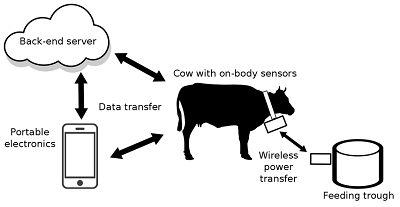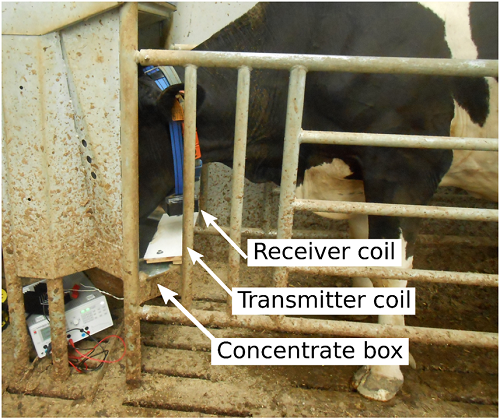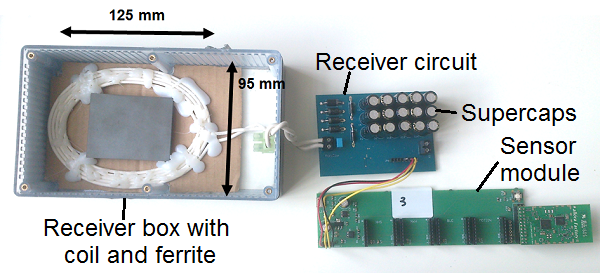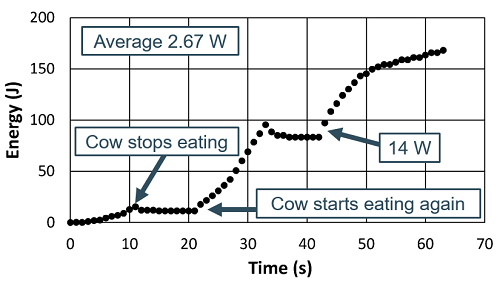About - Publications - Blog
The Wireless Charging of Cows
Summary
Dairy farmers increase their herd sizes, but this hinders the capability to timely detect illnesses. A solution is the deployment of automatic health monitoring systems. Unfortunately, due to their high energy consumption, the application possibilities remain limited. In this work, we charge cows wirelessly (or at least their on-body sensors) by inductive coupling. The system is mounted at the eating trough, and the amount of energy transferred each eating turn is determined experimentally.
References
Ben Minnaert, Bart Thoen, David Plets, Wout Joseph, Nobby Stevens,
Wireless Energy Transfer by Means of Inductive Coupling for Dairy Cow
Health Monitoring. Computers and Electronics in Agriculture, 152, (2018)
101-108.
Paper: [pdf]
Ben Minnaert, Bart Thoen, David Plets, Wout Joseph and Nobby Stevens.
Optimal energy storage solution for an inductively powered system for
dairy cows. Wireless Power Transfer Conference (WPTC), 2017 IEEE. Taipei,
Taiwan, 10-12 May 2017.
Paper: [pdf]
Said Benaissa, Amine M. Samoudi, David Plets, Günter Vermeeren,
Leen Verloock, Ben Minnaert, Nobby Stevens, Luc Martens, Frank A.M.
Tuyttens, Bart Sonck, Wout Joseph, Numerical Assessment of EMF Exposure
of a Cow to a Wireless Power Transfer System for Dairy Cattle. Computers
and Electronics in Agriculture, 151, (2018) 219-225.
Paper: [pdf]
Problem setting
Dairy farmers aim at increasing their herd size, either out of necessity to survive in a cost competitive market or to generate more profits. However, the larger the herd, the more labor intensive and less practical it becomes for the farmer to monitor all the dairy cows. Nevertheless, a strict monitoring of all cows remains necessary to timely detect anomalies in the health of the farm animals as a late detection may lead to significant costs.
To manage the increasing herd size in an economically efficient way, the farmer can rely on automatic health monitoring systems for the collection and interpretation of animal data. They enable the farmer to detect illnesses, predict the calving moment, and track the movement and location of the animal.
An important barrier is the high energy consumption. Indeed, powering different accurate sensors and wirelessly transferring the data in real-time to a back-end server requires a significant amount of energy. As a result, the farmer has to manually replace the battery every few months or every year. This contradicts with the objective of a maintenance-free, automatic health system to reduce the labor cost.

Figure 1:On-body sensors measure different parameters of the animal, which are wirelessly transferred to a back-end server for data interpretation. The back-end system and the on-body system can share its information with the farmer's portable electronics and e.g., alert the farmer when a possible disease is detected. The on-body health system is wirelessly charged at a feeding trough.
Solution
A solution to the above problems is wirelessly charging the monitoring system at the drinking or eating trough by inductive coupling (Fig. 1). In this way, the system can wirelessly receive enough energy every day to continue operation. By installing a transmitter coil at an eating trough and a receiver coil in the collar (which can serve as a central hub for on-body sensors), wireless power transfer can be realized during the eating time slots at a dairy farm (Fig. 2).

Figure 2: A cow, equipped with the wireless power transfer system with inductive coupling, is eating at the concentrate feeding box.
Field measurements
For this work, a transmitter was installed at a concentrate feeding box (Fig. 3). The receiver was attached at the collar of the cow (Fig. 4). Each experiment consisted of one eating turn of a cow (Fig. 4).

Figure 3: A transmitter coil is installed at the concentrate feeding box. When the cow eats, energy is transferred wirelessly to a receiver coil, located at the collar of the dairy cow.

Figure 4: On the left, the bottom of the receiver box, containing the receiver coil with a ferrite core. On the right, the receiver's circuit with the supercapacitor bank and the sensor module which allows the easy plug-in of different sensor systems.
Fig. 5 shows one of the best measurements with respect to maximal energy transfer. The energy transferred to the receiver is plotted as function of time. In this specific measurement, 168 J was transferred in 63 s, which corresponds to an average power transfer rate of 2.67 W. However, the wireless power transfer is not constant during time. When the cow eats, both the distance and the orientation of the receiver coil to the transmitter are variable, resulting in different energy transfer rates. The wireless power transfer is zero when the cow stops eating and lifts her head, because the distance between transmitter and receiver becomes too large to continue energy transfer. This can be observed as horizontal plateaus. On the other hand, during some moments, the receiver is nearly optimally oriented, and the energy transfer is high. For example, between 22 and 34 s and between 43 and 50 s, an average power transfer of 7.0 and 8.5 W is realized, respectively. A peak power transfer of 14 W (at 42 s) was registered during this measurement.

Figure 5: The amount of transferred energy as function of time: example of a measurement.
The average eating time over all 40 measurements was 160 s. The shortest measurement lasted 49 s, the longest 297 s. Fig. 6 shows the distribution of the transferred energy per measurement. On average, an energy transfer of 96 J per meal was realized, with a minimum and maximum obtained value of 8 and 408 J, respectively. If the transmitter would be installed at an automatic milking system, an energy transfer of 1.3 kJ to 2.5 kJ per day could be expected.

Figure 6: Distribution of the transferred energy per measurement.
Existing cattle monitoring systems consume from about 5 J to 5 kJ of energy per day, depending on their functionality, measured parameters, applied technology, and in particular the number of times a day data is transmitted and at which bit rate. Our results indicate that inductive wireless power transfer is a viable technology for certain applications to resolve the energy provision challenge for the automatic health monitoring of dairy cows.
You can see the system in action in the video below (in Dutch).